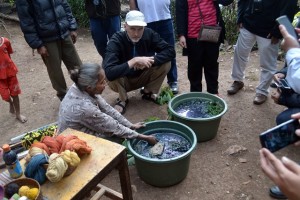By Rob Finlayson, originally posted at Agroforestry World Blog

Understanding how to manage timber and non-timber forest products is particularly important for poorer households in Indonesia. Action research to improve farmers’ understanding is underway.
Combining tree planting with management of non-timber forest products (NTFPs) has been an important part of many Indonesian farmers livelihoods’ strategies for a long time, with each element playing a different role.
Such integration, however, faces significant impediments in the poorer, more arid provinces of Nusa Tenggara Timur (NTT/Eastern Southeastern Indonesia) and Nusa Tenggara Barat (NTB/Western Southeastern Indonesia), where annual farm households’ average cash incomes are as low as IDR 1.26 million (± USD 90 at October 2015 rates), according to the Indonesian Bureau of Statistics in 2005. NTT and NTB have among the lowest socioeconomic levels compared to other provinces in Indonesia. In 2010, the two provinces ranked at 32 and 31 (from a total of 33 provinces) in the Human Development Index.
A project to help farmers overcome the impediments, called Development of Timber and NTFP Production and Market Strategies for Improvement of Smallholders’ Livelihoods in Indonesia, is being led by the World Agroforestry Centre in partnership with the Center for International Forestry Research; Forestry Research and Development Agency of the Ministry of Forestry; University of Western Australia; World Wildlife Fund Indonesia Nusa Tenggara Programme; Universitas Mataram; Threads of Life; and the Pokja Hutan Rakyat Lestari (Farm Forest Consortium); supported by the Australian Centre for International Agricultural Research (ACIAR) and the CGIAR Research Program on Forests, Trees and Agroforestry.
The project, which began in 2013 and will end in 2016, is focusing on Central Java as well as NTB and NTT because of the historical forest-sector links that remain active between the three provinces, including value chains, making research results widely applicable across the sites.

Background studies showed that timber at study sites in Gunungkidul, Central Java contributed up to 12% of total farm household income; timber planting by farmers inside state forests provided substantial annual benefits per household; and a combination of intercropping using highly commercial NTFPs more than doubled the average household income at study sites in NTB. The research partners saw significant opportunities to develop NTFP enterprises and the informal NTFP sector to increase total value and numbers of people employed.
Building on these and other studies supported by ACIAR and partner agencies, it became clear that farmers in the more arid and remote areas of the eastern part of the Indonesian archipelago had insufficient understanding of the trade-offs between timber and NTFPs related to the cost of allocating household labour and financial capital. Second, they used no or ineffective silvicultural practices that did not optimise production of timber and NTFPs. Third, there was insufficient understanding of market characteristics for different types of products (both timber and NTFPs) to add value in value chains and what markets required to improve the products’ qualities. Furthermore, there had been conflict over integrated uses and management of timber and NTFPs in the region. And, lastly, there were unfavourable policies governing farm and landscape management that prevented value chains from effectively providing fair profit margins for community producers. Many of these issues were also relevant to farmers in Central Java, particularly, those growing teak.

The NTFPs in Nusa Tenggara and Central Java that were the most important to farmers included ‘sirih’ (betel leaf; Piper betle), ‘pinang’ (betel nut; Areca catechu), ‘rumput ketak’ (Lygodium circinatum Burm.f. Sw), coconut, honey, bamboo, candlenut, ginger, turmeric, ‘lengkuas’ (galangal; Alpinia galangal), indigo (Indigofera tinctoria), fruit (durian and avocado) and fuel wood.
NTFPs hold significant potential for smallholders because even though current trade volumes are small there is high growth potential for niche markets; the production of NTFPs is more flexible and much less capital intensive than the mainstream crops of coffee, cocoa and citrus; and producers of those mainstream crops in Nusa Tenggara now face stiff competition from other parts of Indonesia and globally.
The project is looking for answers to several questions. First, how can forestry and agroforestry management practices be improved to enhance integrated timber and NTFP management and production? Second, what are suitable strategies for effective integrated marketing of timber and NTFPs for smallholders? Third, what policy factors significantly hinder smallholders’ production and competiveness in timber and NTFPs and how can those factors be addressed? And, lastly, what are the key characteristics of an extension program that can deliver information on best practices for timber and NTFP management, production and value-added marketing?
Many of these questions are being answered in the field at the time of writing. Later stories will provide an insight into their progress.











